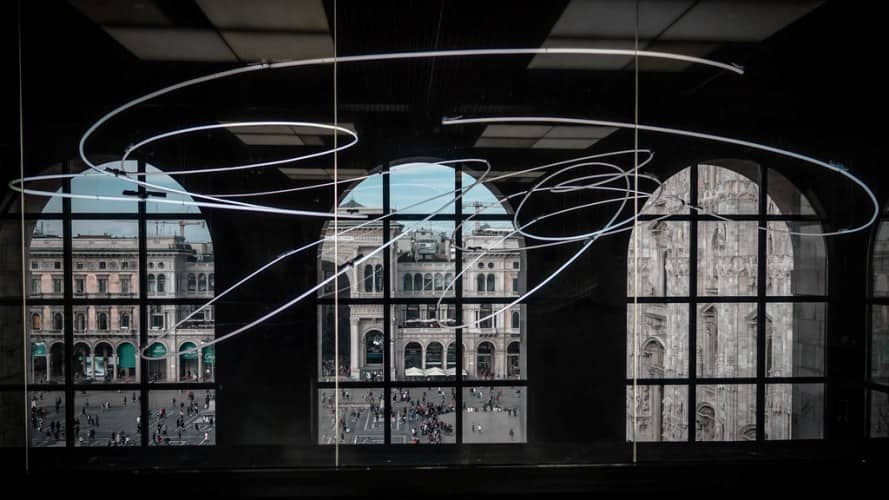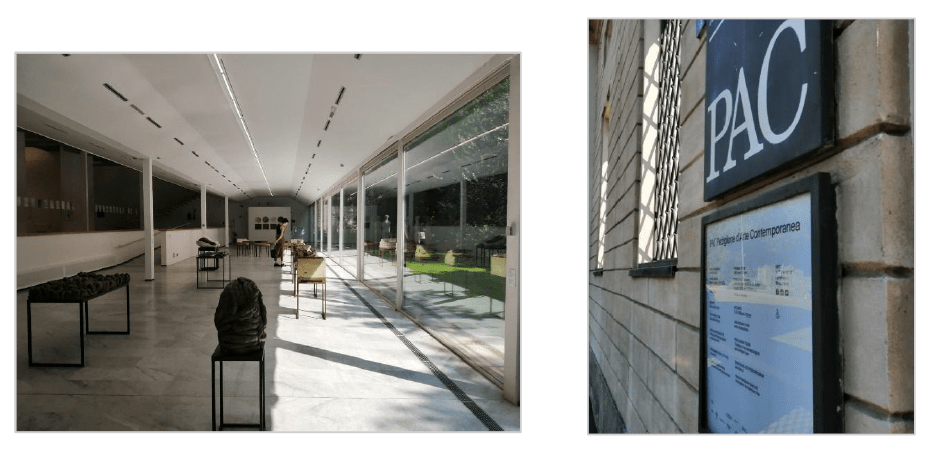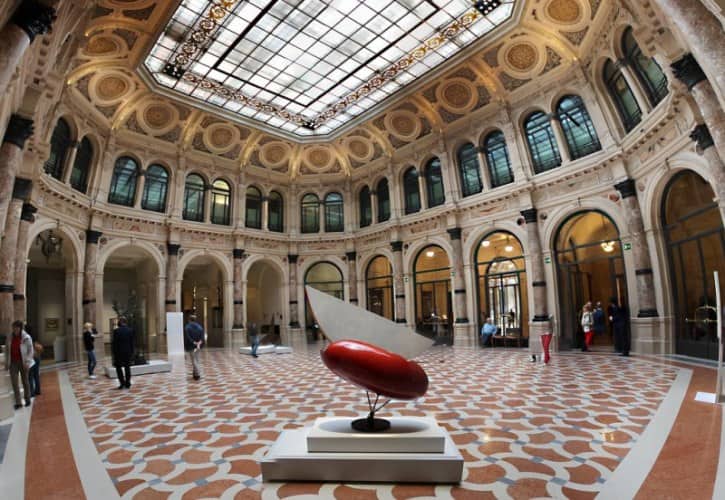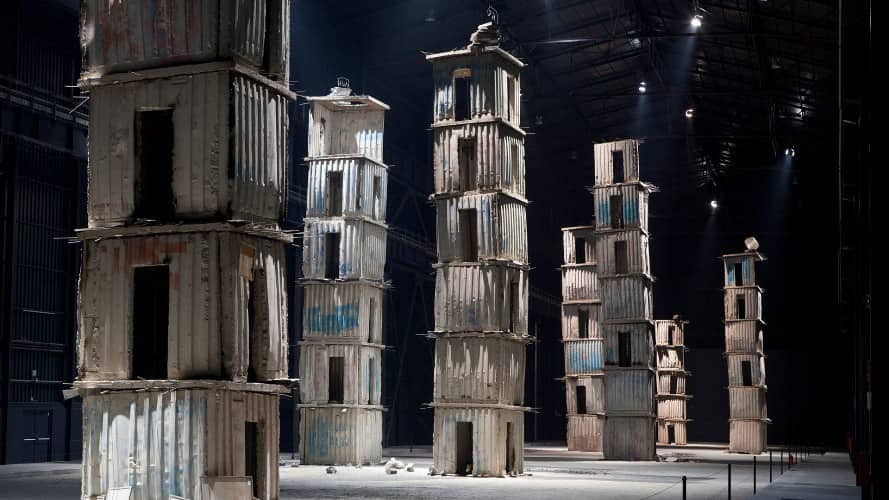Milan is a city known for its aperitifs, for the Duomo and its museums. Moreover, there are historical places of interest such as the Pinacoteca di Brera or the Cenacolo Vinciano. The Lombard capital is not only this – the city is rich in galleries, museums and foundations where contemporary art is the protagonist.

Who has never said, in the face of contemporary work, would I have been able to do it too?Well, if you decide to discover something more and if you would have been able to do it yourself, we suggest six places where the contemporary is the protagonist.Museo del '900 and Padiglione d’Arte Contemporanea, both managed by the Milano Municipality; Triennale and Gallerie d’Italia, offer temporary exhibitions of contemporary art run by foundations; Fondazione Prada and Pirelli HangarBicocca, focused on contemporary art managed and sponsored by private companies.
MUSEO DEL 900

The Museo del Novecento is a cultural institute of the City of Milan and depends on the City of Milan's Central Directorate of Culture.The Museum is located inside the Palazzo dell’Arengario in Piazza Duomo in Milan. Opened in December 2010, the Museum was born from the desire to present a path dedicated to Italian painting and sculpture of the 20th century.The works owned by the City of Milan come from the collections donated by citizens and from the purchases made during the last century by the Gallery of Modern Art.After several temporary locations, such as Villa Reale, Pac and Cimac, in 2000 came the decision to convert the spaces of the Arengario in the new Museo del Novecento. The alderman Salvatore Carrubba, with the Central Culture Director Alessandra Mottola Molfino and the Director of Civic Art Collections Maria Teresa Fiorio, decided to launch a public tender to renew the spaces. The winning project was the one by the Group Rota (Italo Rota and Fabio Fornasari).The new Museum returns its collections to the citizens. It gives the proper recognition to those collectors, gallery owners, and institutions who have collaborated to form one of the most important Italian art collections of the 20th century for more than a century. The Museum shows the public about 400 selected works from the 4000 owned by civic art collections and periodically offers temporary exhibitions dedicated to contemporary art.The path “begins” in 1902, with Quarto Stato of Giuseppe Pellizza da Volpedo, dedicated a room along the spiral ramp with free access.The Collection also includes Pablo Picasso, Georges Braque, Paul Klee, Vasily Kandinsky and Amedeo Modigliani. The exhibition continues with Futurism, and monographic spaces dedicated to Giorgio de Chirico, Giorgio Morandi, Arturo Martini and Fausto Melotti.There is a room dedicated to informal works on the third floor and Lucio Fontana dedicated to the entire third floor. Through a path, which connects the Museum to the Royal Palace, you access the final section, which deals with the period between the early sixties and early eighties. From Kinetic and Programmed Art, we reach pop experiences and analytical paintings, while conceptual art is represented in its Italian and international declinations.The museum’s path ended in the 1980s with Mimmo Paladino, Nunzio Di Stefano, Paolo Icaro, Giuseppe Spagnulo and Alighiero Boetti.
CONTEMPORARY ART PAVILLION (PAC)

The PAC history begins in 1947 when the City of Milan, in search of a new space for the collections of the Civic Collections of the 20th century, choose the former stables of the Villa Reale, destroyed by the bombings of 1943. The Villa Reale had already been home to the Gallery of Modern Art (GAM) since 1921, but the spaces were insufficient to house a growing museum of contemporary art.The two proposed renovation projects matched two opposing philosophies. The first one favoured a faithful reconstruction of the previous architectural complex and was limited to the adaptation of the interior space. The second option was constructing a completely new building, designed according to the needs of a museum.In March 1948, the project signed by the architect Ignazio Gardella was selected, which reconciles the two points of view: maximum availability and flexibility of the interior space, with the possibility of dose and differentiate the light in the rooms, and a new building that occupies the same area of the original one, on three levels. The result is an architectural space that can be divided and articulated without losing the original environmental unit.The Pavilion opened in 1954 as a venue for 20th-century civic collections. However, almost immediately, it captures the demand for openness to abroad that after the Second World War affect the world of culture and art. Since the beginning, the museum’s spaces house some temporary exhibitions (the first one was a monograph by Georges Roualt).After a long period of closure for restorations, in 1979, the PAC reopened to investigate more deeply 20th-century arts and to acquire works to complete the civic collections.The flexibility of its spaces allows the Pavilion to adapt as a sensitive place in harmony with heterogeneous artistic experiences, as a non-invasive container, often re-interpreted through artists’ interventions.In 1993, a mafia attack destroyed part of the building: it was rebuilt by Ignazio Gardella in 1996, according to the original project, with fundamental technical improvements that bring it closer to the avant-garde exhibition spaces.Since 2003 the PAC has been a member of AMACI, Association of Italian Contemporary Art Museums, to share experiences and energies to promote contemporary art in Italy and other museums and spaces engaged in the national territory. PAC also interacts with the most important players in Italy dealing with contemporary art.
TRIENNALE

The first International Exhibition of Decorative Arts was held in Monza in 1923. The event, which took place every two years, was set in the Villa Reale park to stimulate relations between industry, art, and society. After-war, Italy puts its prospects for recovery in the industries, betting on creative design as an element of its productions' uniqueness. From the beginning, the event was marked by a unified conception of all forms of art and creative expression linked to social evolutions and economic development.In 1933 the Monza exposition became “Triennale” and moved to Milan, assuming an autonomous legal personality under Gio Ponti and Mario Sironi's leadership. Giovanni Muzio designed the headquarter, Palazzo dell’Arte, thanks to the five million lira donation of the Bernocchi brothers. The palace is a prestigious, modular and flexible building explicitly designed to host significant events and museum activities.After the Second World War, the institution addressed the reconstruction problem, promoting with Piero Bottoni the construction of the QT8 district and in the 1950s the theme of industrial design, with dedicated exhibitions.During the 1900s, the Triennale contributed to the unity of the arts and Italian architecture and design development. It subsequently expanded its areas of interest to become a centre for innovation and creative research, an integrated communication system and cultural production that today targets ever broader and more diverse audiences. Its success results from a work of design and planning of activities, articulated according to a broad vision of contemporary.For more than eighty years, the Triennale has been a reference point for dialogue between society, art and enterprise, in the words of Stefano Boeri, president of the institution, “a place where different points of view are considered, and controversial topics are discussed”.

GALLERIE D'ITALIA

The Gallerie d’Italia are composed of three locations: Naples, Vicenza and Milan. They are born from Progetto Cultura, the "strategic container" of the cultural activities of Intesa Sanpaolo. In this plan, renewed every three years, a plurality of interventions finds space. The values that inspire the Project are the protection, enhancement, public enjoyment, and dissemination of knowledge of the artistic and cultural assets that constitute Italy's incomparable artistic wealth collected by the Financial Institution. One of the guidelines along which the plan develops is the enhancement of the Group's conspicuous and prestigious historical, artistic, architectural and archival heritage to share it with the community. Hence the creation of a network of museum and cultural poles, the Gallerie d'Italia project has reached one of its most important moments with the Gallerie's opening in Milan. In November 2011, the section dedicated to the art of the nineteenth century was inaugurated. Among the rooms of the palaces Anguissola and Brentani, located between Via Manzoni and Via Morone, are exhibited 19th-century works from the collections of the Cariplo Foundation and Intesa Sanpaolo in a path entitled “Da Canova a Boccioni” and curated by Fernando Mazzocca.In 2012, the Milanese galleries are enriched with an additional section, reaching 8,300 square meters of total area. The new space, the historic offices of the Banca Commerciale Italiana, is inaugurated by hosting an exhibition project called “Cantiere del ‘900” to enhance the very rich 20th century collections by Intesa Sanpaolo. The first exhibition curated by Francesco Tedeschi presents 189 works of the Italian Post-World War chosen by the collections of the bank (Le Gallerie d’Italia - Spazi per l’arte e la cultura nel cuore delle città, 2019).Today, alongside the permanent collection works, there are temporary exhibitions, often in collaboration with other important institutions in the Italian territory.
PIRELLI HANGAR BICOCCA

Pirelli HangarBicocca is a non-profit foundation established in 2004, which has converted a former industrial plant in Milan into an institution for producing and promoting contemporary art. This dynamic centre for experimentation and discovery covers 15,000 square meters, making it one of the largest contiguous exhibition spaces in Europe. It presents major solo shows every year by Italian and international artists. Each project conceived to work closely to the architecture of the complex and explored in depth through a calendar of parallel events. Admission to space and the shows is completely free of charge, and facilitators are on hand to help the public connect with the art. Since 2013, Vicente Todolí has been the foundation’s Artistic Director.The complex, which once housed a locomotive factory, includes public services and educational activities and three exhibition spaces whose original twentieth-century architectural features have been left visible: Shed, Navate, and Cubo. As well as its exhibitions program and cultural events, Pirelli HangarBicocca also permanently houses one of Anselm Kiefer’s most important site-specific works, The Seven Heavenly Palaces 2004-2015, commissioned for the opening of Pirelli HangarBicocca (https://pirellihangarbicocca.org/en/pirelli-hangarbicocca/, 2019).Pirelli HangarBicocca's mission is to make art open and accessible to everyone.For this reason, entry to the exhibitions is always free and cultural mediators are present in the exhibition space, where they answer to the questions of the public and facilitate interaction with the works, organizing weekly guided tours. Free exhibition guides are also available. Made specifically for each exhibition, they are a useful and indispensable tool during the visit. While workshops and activities for children and teens are organized every weekend.
FONDAZIONE PRADA

On 9th May 2015, the Fondazione Prada unveiled its new permanent Milan venue in Largo Isarco. The new Milan venue was conceived by architecture firm OMA, led by Rem Koolhaas. The complex, which is the result of the transformation of a former distillery dating back to the 1910s, is articulated by an architectural configuration that combines preexisting buildings with three new structures, named “Podium”, “Cinema” and “Torre”. The new venue's hallmark is the so-called “Haunted House”, a 4-story building clad in 24 carat gold foil, where pieces from the permanent Collection of the Fondazione Prada are permanently on display.The compound has a gross surface area of 19,000 m2 of which 11,000 m2 is dedicated as exhibition space. The entrance building welcomes visitors to two new facilities, developed through unique collaborations. There is a kids' area, designed by a group of students from the École Nationale supérieure d'architecture de Versailles and a bar where director Wes Anderson has recreated a typical old Milanese café. Then, the courtyards provide a common public ground, open to the city.The main interest is ideas and how humankind has transformed ideas into specific disciplines and cultural products: literature, cinema, music, philosophy, art and science.An attitude of openness and invitation characterizes the new Milano premises' political mood, asserting the possibility of participation at all levels for all generations and trying to find new ways for sharing ideas.The Prada Collection, mainly comprised of works from the 20th and 21st centuries, is conceived as a resource of perspectives and potential energy. The foundation invites a different kind of people to provide new interpretations of undetected ideas from the Collection: curators, artists, architects but also scientists and students, thinkers and writers.


